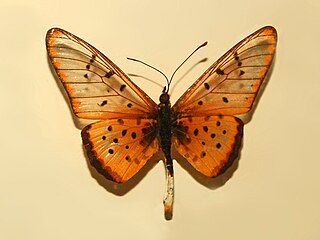
The Charaxinae, the leafwings, are a nymphalid subfamily of butterflies that includes about 400 species, inhabiting mainly the tropics, although some species extend into temperate regions in North America, Europe, China, and southern Australia. Significant variations exist between the species. For example, some are medium sized and bright orange above, but mottled gray or brown below. This underwing coloration helps them resemble a dead leaf when they are at rest, as they keep their wings closed. With relatively few exceptions, the hindwings of the members of this subfamily have jagged edges.

The Satyrini is one of the tribes of the subfamily Satyrinae. It includes about 2200 species and is therefore the largest tribe in the subfamily which comprises 2500 species.

Prepona is a genus of Neotropical charaxine butterflies in the family Nymphalidae. They are strong fliers in tropical forests where they feed on fermenting fruits and animal dung. The underside of the wings is pale greyish or brownish, while the upperside is dark with distinct iridescent blue markings. A few species also have orange markings on the upperside of the wings. They are popular among butterfly collectors.

Erebia is a Holarctic genus of brush-footed butterflies, family Nymphalidae. Most of the about 90–100 species are dark brown or black in color, with reddish-brown to orange or more rarely yellowish wing blotches or bands. These usually bear black spots within, which sometimes have white center spots.

Erebia euryale, the large ringlet, is a species of butterfly belonging to the family Nymphalidae.

Nessaea is a genus of nymphalid butterflies found in the Neotropical realm. Unlike virtually all other butterflies with blue coloration, the blue colors in this genus are due to pigmentation [pterobilin ] rather than iridescence.

Morpho rhetenor, the Rhetenor blue morpho, is a Neotropical butterfly of the family Nymphalidae. It is found in Suriname, French Guiana, Brazil, Peru, Ecuador, Colombia, and Venezuela.

Morpho amathonte is a Neotropical butterfly belonging to the subfamily Morphinae of the family Nymphalidae. It is considered, by some authors, to be a subspecies of Morpho menelaus.

Junonia evarete, the tropical buckeye or South American tropical buckeye, is a South American butterfly of the nymphalid (Nymphalidae) family. It has characteristic eye spots on the wings, which have a wingspan between 4.5 and 6.5 cm. This butterfly is easily confused with Junonia genoveva, the mangrove buckeye. Not only have the common names mangrove and tropical buckeye been confused, but the butterflies themselves have been sometimes misidentified in past literature because the two species have many variations, subspecies and seasonal forms, which makes them difficult to identify or differentiate. Phylogenetic studies demonstrate the separation of evarete and genoveva, but evidence suggests that subspecies and perhaps more species await their descriptions within this group.

Erebia cassioides, the common brassy ringlet, is a member of the subfamily Satyrinae of family Nymphalidae.

Agrias claudina, the Claudina Agrias, is a butterfly of the family Nymphalidae. It is found from Venezuela and Guyana to Bolivia. The subspecies A. c. sardanapalus is found in Ecuador, Brazil and Peru. It is found in primary and secondary rainforest at altitudes between 200 and 600 meters.
Charaxes vansoni, the Van Son's emperor, is a butterfly of the family Nymphalidae. It is found in southern Africa.

Acraea pseudegina is a butterfly of the family Nymphalidae, which is native to the African tropics and subtropics.

Percy Ireland Lathy was an English entomologist who specialised in butterflies. He was an acquaintance of James John Joicey and was associated with Joicey's Hill Museum in Witley, Surrey.

Pronophilina is a Neotropical subtribe of butterflies of the subfamily Satyrinae. They are a species-rich group with highest diversity in the tropical and subtropical mountains, especially the Andes. Before 1970, they were poorly studied, but recent interest has resulted in high rates of species description from previously unexplored mountain ranges. However, there is still a lack of knowledge on their biology and ecology. Their relationship to other groups of Satyrine butterflies and their complex patterns of speciation within and among mountain ranges have led to several biogeographic discussions.
Charaxes virescens is a butterfly in the family Nymphalidae. It is found in the Shaba region in the Democratic Republic of the Congo.

Charaxes pythodoris, the powder-blue charaxes, is a butterfly in the family Nymphalidae. It is found in Sierra Leone, Ivory Coast, Ghana, Nigeria, Cameroon, Gabon, the Republic of the Congo, the Central African Republic, Angola, the Democratic Republic of the Congo, Ethiopia, Uganda, Kenya, Tanzania, Malawi and Zambia.





















